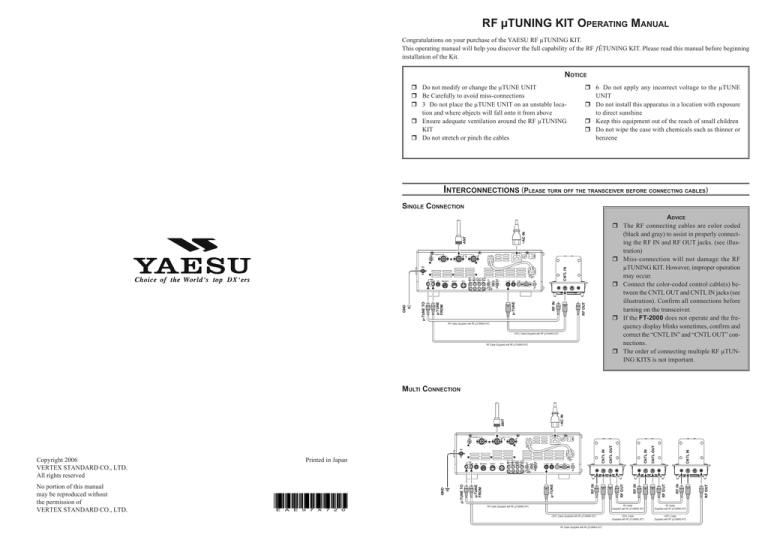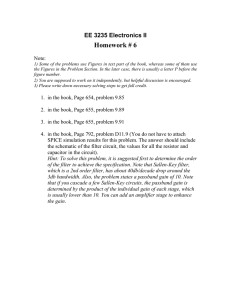
RF μTUNING KIT OPERATING MANUAL
Congratulations on your purchase of the YAESU RF μTUNING KIT.
This operating manual will help you discover the full capability of the RF ƒÊTUNING KIT. Please read this manual before beginning
installation of the Kit.
NOTICE
Do not modify or change the μTUNE UNIT
Be Carefully to avoid miss-connections
3 Do not place the μTUNE UNIT on an unstable location and where objects will fall onto it from above
Ensure adequate ventilation around the RF μTUNING
KIT
Do not stretch or pinch the cables
6 Do not apply any incorrect voltage to the μTUNE
UNIT
Do not install this apparatus in a location with exposure
to direct sunshine
Keep this equipment out of the reach of small children
Do not wipe the case with chemicals such as thinner or
benzene
INTERCONNECTIONS (PLEASE TURN OFF THE TRANSCEIVER BEFORE CONNECTING CABLES)
SINGLE CONNECTION
RF OUT
RF IN
µ-TUNE
µ-TUNE
FROM
µ-TUNE TO
GND
CNTL IN
ANT
~AC IN
ADVICE
The RF connecting cables are color coded
(black and gray) to assist in properly connecting the RF IN and RF OUT jacks. (see illustration)
Miss-connection will not damage the RF
μTUNING KIT. However, improper operation
may occur.
Connect the color-coded control cable(s) between the CNTL OUT and CNTL IN jacks (see
illustration). Confirm all connections before
turning on the transceiver.
If the FT-2000 does not operate and the frequency display blinks sometimes, confirm and
correct the “CNTL IN” and “CNTL OUT” connections.
The order of connecting multiple RF μTUNING KITS is not important.
RF Cable (Supplied
with RF μTUNING
KIT)
(RF µTuning
Kit の付属品
)
RF CABLE
CNTL
Cable (Supplied
with RF μTUNING
KIT)
(RF µTuning
Kit の付属品
)
CNTL
CABLE
RF Cable
(Supplied
with RFKit
μTUNING
KIT) )
(RF
µTuning
RF CABLE
の付属品
E
A
E
9
7
X
7
2
0
RF Cable
(Supplied with RF μTUNING KIT)
CNTL CABLE
Cable
CNTL
(Supplied
with RFKit
μTUNING
KIT) )
(RF
µTuning
の付属品
CNTL CABLE
Cable
CNTL
(Supplied
with RFKit
μTUNING
KIT) )
(RF
µTuning
の付属品
Cable (Supplied
with RF μTUNING
KIT)
(RF µTuning
Kit の付属品
)
RFRFCABLE
RF OUT
RF IN
CNTL IN
CNTL OUT
RF OUT
RF IN
RF OUT
RF Cable
(Supplied with RF μTUNING KIT)
RF Cable
(Supplied
with
RF RF
μTUNING
KIT) KIT)
(RF µTuning
KitTUNING
)
RFCable
CABLE
の付属品
RF
(Supplied
with
CNTL
Cable (Supplied
with RF μTUNING
KIT)
(RF µTuning
Kit の付属品
)
CNTL
CABLE
CNTL IN
CNTL OUT
RF IN
µ-TUNE
µ-TUNE
FROM
µ-TUNE TO
No portion of this manual
may be reproduced without
the permission of
VERTEX STANDARD CO., LTD.
Printed in Japan
GND
Copyright 2006
VERTEX STANDARD CO., LTD.
All rights reserved
CNTL IN
ANT
~AC IN
MULTI CONNECTION
OPERATION
The RF μTUNING KIT provides ultra-sharp RF selectivity for the front end of the transceiver. Very high Q is made possible by the
narrow-band design. Three RF μTUNING KITS are available. The MTU-160 covers the 1.8 MHz band. The MTU-80/40 covers the 3.5
and 7 MHz bands. The MTU-30/20 covers 10.1 and 14 MHz bands.
When any (or all) of the three optional units are installed, they will be automatically adjusted to center on your operating frequency.
The narrow bandwidth is especially useful on the low bands, when many strong signals are being received via NVIS propagation (Near
Vertical-Incidence Signals) within a narrow bandwidth. The added protection for the RF stage is especially helpful in preventing IMD
and blocking.
The RF μTUNING KIT, provides a Q and shape factor much higher than that afforded even by VRF. It can also be manually adjusted to
provide relief from interference as close as 10 kHz away. The insertion loss of the RF μTUNING KIT is higher than that of the VRF
circuit, so if Noise Figure is a concern you may select the VRF circuit, instead of RF μTUNING KIT, via the Menu of the FT-2000
transceiver.
1. Press the [VRF] button momentarily. The “
” icon will appear at
the FLT column of the Receiver Configuration Indicator on the FT2000 display, and the μ-Tune circuit will be engaged.
The μ-Tune circuit will
automatically align itself
to your operating frequency.
µ-Tune Filter is activated
The VRF circuit will engage when you choose an amateur band
which is not connected to a μ-TUNE UNIT.
2. Now rotate the [VRF] knob to peak the response (background noise) or
reduce interference.
Top Band Edge
You may observe the relative peak point
of the μ-Tune filter in the Tuning Offset
Indicator on the display while tuning the
Bottom Band Edge
[VRF] knob.
The amount of change in the center frequency of the μ-Tune filter, when rotating the [VRF] knob by one click, can be configured using Menu
035 GEnE μT DIAL
item “035
DIAL.”
3. Press the [VRF] button (momentarily) once more to disengage the μTune filter. The “
” icon will turn on in place of “
” icon. In this
mode, only the fixed bandpass filter for the current band will be engaged.
“VRF” icon Tuning Offset Indicator
Main Tuning Dial knob
[VRF] button
µ-TUNE AND VRF: COMPARISONS TO FIXED BANDPASS FILTERS
µ-Tune
Inspection of the illustrations to the right will demonstrate the profound
advantage of the μ-Tune circuit. In illustration [A], the gray area represents the passband of a typical fixed bandpass filter covering the 1.8 ~ 3
MHz range; this is typical of the kind of bandpass filter found in many
high-quality HF receivers today. Note also the hypothetical distribution of
signals across the 160-meter band.
In illustration [B], note the narrow white segment within the gray passband
of the fixed BPF. These narrow segments represent the typical bandwidth
of the μ-Tune filter, and one can see that the passband has been reduced
from about 750 kHz in the case of the fixed BPF) to a few dozen kHz when
μ-Tune is engaged. The vast majority of the incoming signals are outside
the passband of the high-Q μ-Tune filter, and they will not impinge on any
of the RF/IF amplifiers, the mixers, or the DSP. Very strong out-of-band
signals like this can cause Intermodulation, blocking, and an elevated noise
floor for a receiver.
A
1.8MHz
2.5MHz
FRONT-END BAND WIDTH
B
1.8MHz μTUNE BAND WIDTH
2.5MHz
14.5MHz
22MHz
[VRF] knob
QUICK NOTE
The permeability-tuning concept utilized in the μ-Tune
circuit dates back many decades, as it was incorporated
in such classic transceivers as the FT-101 and FT-901
series, in addition to the FT DX 401 and similar models.
The μ-Tune circuit in this RF μTUNING KIT is the highest development of this circuit concept ever employed
in an Amateur transceiver, and is adopted in our highest-grade transceiver FT DX 9000 series.
VRF
In this example, illustration [a] depicts a typical fixed bandpass filter covering 14.5 to 22 MHz, and once again the gray shaded area depicts the
fixed bandpass filter’s frequency coverage. The vertical lines in the illustration represent hypothetical signals throughout this frequency range.
Figure [b] shows the same fixed BPF, with the white area representing the
typical passband of the VRF filter operating in the same frequency range.
Although the selectivity of the VRF is not as tight as that of the μ-Tune
filter, the RF selectivity of the VRF preselector is still magnitudes better
than that of the usual fixed bandpass filter, affording significant protection
against the ingress of high signal voltage from strong out-of-band signals.
a
FRONT-END BAND WIDTH
b
14.5MHz
VRF BAND WIDTH
22MHz
ADVICE
ADVICE
バンドパスフィルター
Bandpass Filter
45-60 MHz
20.9-30.1 MHz
アンテナ
Antenna
1
2
Antenna Selector
With μ-Tuning, the center frequency of the filter is continuously
adjustable throughout its operating range. The quality L/C components ensure high Q of the circuit and a tight passband. The
RF preselection design task required the selection of quality L/C
components, but the crafting of a tuning mechanism and tuning
concept that preserves system Q while providing consistent
smooth automated tuning over a wide operating frequency range.
The smooth tuning is achieved by varying the inductance over a
wide range; this is accomplished by motor-driving a large 1.1”
(28 mm) ferrite core stack through a 2” high (50 mm) coil structure. The Q of the μ-Tune circuit is over 300, and yields unmatched RF selectivity for outstanding rejection of undesired signals.
ア ン テ ナ セ レク タ ー
The μ-Tune filters are the most advanced, selective RF preselector filters ever incorporated into an Amateur Radio transceiver. The
RF selectivity provided by μ-Tune can be of tremendous value in ensuring quiet, intermod-free reception even in the most crowded
bands on a contest weekend. The μ-Tune filters provide RF selectivity on the order of a few dozen kHz at -6 dB, at the expense of
a few dB of system gain on bands where noise figure is seldom an issue. You will notice that the S-meter deflection, when μ-Tune
is engaged, is slightly less than when it is out of the circuit. This is normal. If your antenna system gain is so low that it is impossible
to hear band noise when μ-Tune is engaged (highly unlikely), just switch it out or revert to the VRF system, which has slightly less
insertion loss.
As you tune around on an amateur band with μ-Tune engaged, the microprocessor automatically commands the stepper motor to
drive the toroid core stack and center the filter on your current operating frequency (the tuning resolution is 5 kHz). You may,
however, use the [VRF] knob to skew the filter response to one side or the other of your operating frequency, to deal with heavy
interference on either side. To re-center the μ-Tune filter on the operating frequency, and eliminate any offset, press and hold in the
[VRF] switch for two seconds.
You can use the μ-Tune circuit on the Sub Band Receiver (VFO-B). However, in this case, the stepper motor does not drive the
toroid core to center the filter on your operating frequency. You must adjust the peak response (background noise) or reduce
interference by rotating the [VRF] knob.
010 diSP
You may always observe the peak point of the μ-Tune filter in the Tuning Offset Indicator on the display via Menu item “010
BAR SEL
SEL.”
While μ-Tune is a superior RF preselection circuit, it may be disabled via the Menu on the FT-2000; if this is done, the VRF circuit
035 GEnE μT DIAL
will engage when the [VRF] button is pressed. To disable μ-Tune, enter the Menu item “035
DIAL” of the FT-2000 then
set the selection to “OFF.”
VRF
13.9-20.9 MHz
THRU
9.9-13.9 MHz
6.9-9.9 MHz
4.7-6.9 MHz
3.4-4.7 MHz
1.7-2.5 MHz
SPECIFICATIONS
Case Size (WxHxD): 4.7” x 5” x 12.9” (120 x 127 x 328 mm)
Weight (Approx.): 5.7 lbs (2.6 kg)





